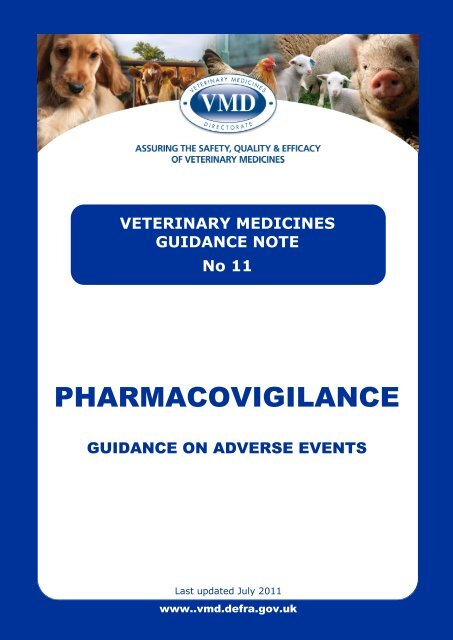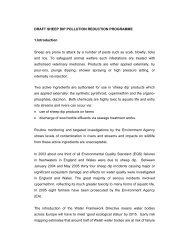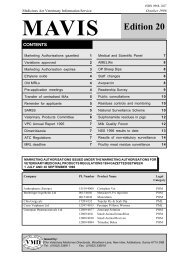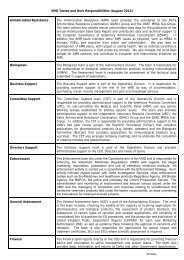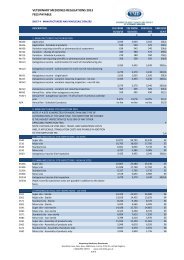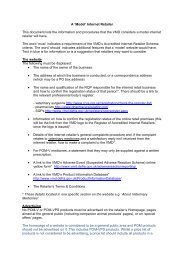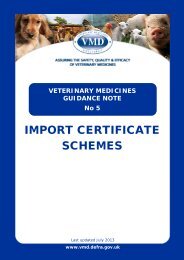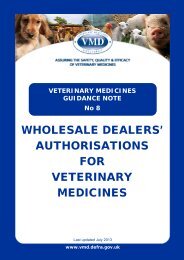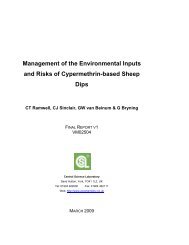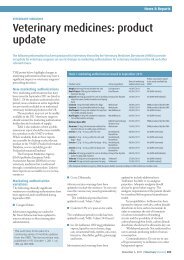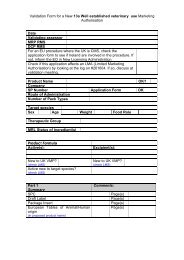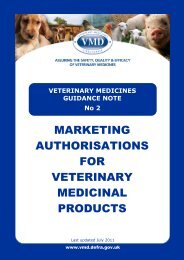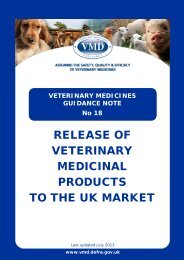Download - Veterinary Medicines Directorate - Defra
Download - Veterinary Medicines Directorate - Defra
Download - Veterinary Medicines Directorate - Defra
You also want an ePaper? Increase the reach of your titles
YUMPU automatically turns print PDFs into web optimized ePapers that Google loves.
VETERINARY MEDICINES<br />
GUIDANCE NOTE<br />
No 11<br />
PHARMACOVIGILANCE<br />
GUIDANCE ON ADVERSE EVENTS<br />
Last updated July 2011<br />
www..vmd.defra.gov.uk
VMGN No. 11<br />
QUICK START GUIDE<br />
This <strong>Veterinary</strong> <strong>Medicines</strong> Guidance Note (VMGN) is aimed primarily at Marketing<br />
Authorisation Holders (MAH) and is intended to provide guidance on pharmacovigilance<br />
and the reporting of adverse events.<br />
The quick start guide is a summary of the provisions of the <strong>Veterinary</strong> <strong>Medicines</strong><br />
Regulations (VMR); detailed information is found in the body of the guidance note.<br />
MAHs have a legal obligation to record any information which they receive about adverse<br />
events involving their veterinary medicinal products. Adverse events associated with<br />
veterinary medicines include adverse reactions in animals which occur after use in<br />
accordance with the advice on the label or following off-label use, and suspected lack of<br />
expected efficacy after use in accordance with the label, and adverse reactions in humans<br />
following exposure to a veterinary medicine or a treated animal.<br />
MAHs must report any animal adverse events involving death, permanent disability, lifethreatening<br />
illness or congenital abnormality, and all human reactions, to the relevant<br />
competent authority within 15 days of their receipt of the information. For adverse events<br />
which occur in the UK, the VMD is the relevant competent authority.<br />
The scope of pharmacovigilance includes incidents arising from exposure to a veterinary<br />
medicine present in the environment, and issues concerning the validity of withdrawal<br />
periods.<br />
MAHs must include reports of all adverse events and other pharmacovigilance issues<br />
involving a veterinary medicine in the Periodic Safety Update Report (PSUR) for the<br />
product. A scientific evaluation of the risk-benefit balance of the veterinary medicine is an<br />
important aspect of a PSUR, which should also include an estimation of exposure to the<br />
veterinary medicine and the incidence of adverse events associated with it.<br />
The VMD should be informed immediately about any concerns relating to the safety of a<br />
veterinary medicine arising from pharmacovigilance or resulting from quality issues.<br />
FURTHER INFORMATION<br />
For more information on pharmacovigilance please contact the VMD‟s pharmacovigilance<br />
team on 01932 338427 or alternatively contact VMD reception on 01932 336911 and<br />
quote “pharmacovigilance”.<br />
2
VMGN No. 11<br />
TABLE OF CONTENTS<br />
Contents Paragraph Page<br />
Introduction 1 4<br />
Qualified Person for Pharmacovigilance (QPPV) 5 4<br />
Adverse Events 10 5<br />
Reporting Requirements for Adverse Events 13 6<br />
Human adverse reaction 20 7<br />
Suspected lack of expected efficacy 21 8<br />
Off-label use/misuse 24 8<br />
Reports Requirements for other Pharmacovigilance Issues<br />
Validity of withdrawal periods 26 8<br />
Environmental Problems 29 9<br />
Periodic Safety Update Reports (PSUR) 32 9<br />
Release of Information by the MA Holder 43 11<br />
Change of MA Holder 45 11<br />
Pharmacovigilance Obligations of ATC Holders 46 11<br />
Exemption Scheme for Pet Animal <strong>Medicines</strong> 47 12<br />
Further Information 48 12<br />
ANNEX A 13<br />
Examples of Serious Non-fatal Adverse<br />
Events by Animal Species<br />
3
VMGN No. 11<br />
Introduction<br />
1. This is one of a series of <strong>Veterinary</strong> <strong>Medicines</strong> Guidance Notes (VMGN) explaining<br />
the requirements under the <strong>Veterinary</strong> <strong>Medicines</strong> Regulations (VMR). The VMR are<br />
revoked and replaced on a regular basis, so the references to them should be read<br />
as referring to the ones that are currently in force. Therefore, the date and number of<br />
the Statutory Instrument are not shown in this VMGN. This VMGN will be updated as<br />
necessary and the date of the most recent update is shown on the front cover.<br />
2. The VMR set out the UK controls on veterinary medicines, including their<br />
manufacture, advertising, marketing, supply and administration. VMGN 1 Controls of<br />
<strong>Veterinary</strong> <strong>Medicines</strong>, which is published on the <strong>Veterinary</strong> <strong>Medicines</strong> <strong>Directorate</strong>‟s<br />
(VMD) website http://www.vmd.defra.gov.uk/pdf/vmr11/VMGN01.pdf provides basic<br />
information about the scope of the Regulations and the requirement for Marketing<br />
Authorisations (MA).<br />
The science and activities relating to the detection, assessment, understanding and<br />
prevention of adverse effects or any other medicine-related problem are known as<br />
pharmacovigilance. <strong>Veterinary</strong> pharmacovigilance concerns the safety of veterinary<br />
medicines used for the treatment, prevention or diagnosis of disease in animals.<br />
This note concerns the provisions for veterinary pharmacovigilance in the UK.<br />
Further information, including guidance on reporting an adverse event (AE), can be<br />
found on the VMD website (www.vmd.defra.gov.uk) under Pharmaceutical Industry.<br />
3. The VMR primarily place reporting obligations on marketing authorisation holders<br />
(MAH). Under the VMR failure to comply with the pharmacovigilance reporting<br />
requirements is an offence. As the competent authority in the UK, the <strong>Veterinary</strong><br />
<strong>Medicines</strong> <strong>Directorate</strong> (VMD) has established a dedicated team of experts to<br />
discharge its pharmacovigilance responsibilities. The pharmacovigilance team<br />
monitors adverse events to veterinary medicinal products in all animal species and in<br />
humans.<br />
4. Guidance on pharmacovigilance is published by the European Commission in The<br />
Rules governing medicinal products in the European Union, Volume 9B – Guidelines<br />
on Pharmacovigilance for Medicinal Products for <strong>Veterinary</strong> Use, which can be found<br />
on http://ec.europa.eu/health/documents/eudralex/vol-9/index_en.htm<br />
Complementary guidance to Volume 9B can be found on the EMA website at<br />
http://www.ema.europa.eu/ema/index.jspcurl=pages/regulation/document_listing/do<br />
cument_listing_000170.jsp&murl=menus/regulations/regulations.jsp&mid=WC0b01ac<br />
058002ddca&jsenabled=true. This VMGN is intended to supplement the European<br />
Commission guidance and should be read with it.<br />
Qualified Person for Pharmacovigilance (QPPV)<br />
5. The VMR require that each Marketing Authorisation Holder (MAH) must have<br />
permanently and continuously at their disposal an appropriately qualified person<br />
responsible for pharmacovigilance. The term “appropriately qualified” is not defined<br />
in the VMR. However, the VMD considers that any person who is capable of<br />
competently performing the following specific duties would meet the requirements:<br />
4
VMGN No. 11<br />
establish and maintain a system that ensures that information about all adverse<br />
events that are reported to the MAH is collected and collated in order to be<br />
accessible at least at one point within the Community;<br />
ensure that any request from the Secretary of State (SoS) for the provision of<br />
additional information necessary for the evaluation of the benefits and risks<br />
afforded by a VMP is answered fully and within any time limit imposed. Such<br />
information may include details of the volume of sales of the veterinary medicinal<br />
product concerned and, if available, details of prescriptions;<br />
provide the SoS with any other information relevant to the evaluation of the<br />
benefits and risks relating to a VMP, including appropriate information on postmarketing<br />
surveillance studies.<br />
6. Additionally, the QPPV may fulfil their duties for the whole of the EU and must reside<br />
in the Community. If the QPPV lives outside the UK, the MAH holds the legal<br />
responsibility for the UK obligations placed on the qualified person. The MAH also<br />
holds ultimate responsibility if the QPPV does not fulfil their duties.<br />
7. The MAH must ensure that it is able to receive and investigate reports of adverse<br />
events that occur in the UK. An easily accessible telephone line must be available 24<br />
hours a day to take details of adverse events and to provide advice to product users.<br />
8. The VMR do not specify how the QPPV discharges these responsibilities. In the<br />
absence of such guidance the VMD takes the view that he or she may delegate<br />
these functions to suitably qualified colleagues on a temporary basis or for<br />
management reasons. Within a company, one person may be the QPPV for all<br />
products or different people may handle different authorisations. Similarly, one<br />
person may be the QPPV for a product throughout the Community or there may be<br />
different ones for each national MA. All applications for national MAs should be<br />
accompanied by the following information:<br />
the name, address(es) and contact details of the QPPV;<br />
the Curriculum Vitae of the QPPV and a description of the back-up procedure to<br />
apply in their absence, including the information relevant to their role<br />
(qualifications, training and experience);<br />
the job description of the QPPV.<br />
9. The pharmacovigilance premises, records and documents used by a MAH may be<br />
inspected by the authorities at any time.<br />
Adverse Events<br />
10. The Commission guidance has adopted the term “adverse event” used in VICH<br />
Guideline 24 instead of “adverse reaction”. (VICH is the International Cooperation on<br />
Harmonisation of Technical Requirements for Registration of <strong>Veterinary</strong> Medicinal<br />
Products.)<br />
An adverse event is any observation in animals, whether or not considered to be<br />
product-related, that is unfavourable and unintended and that occurs after any use of<br />
5
VMGN No. 11<br />
a veterinary medicine. Adverse events associated with veterinary medicines include<br />
adverse reactions in animals which occur after use in accordance with the advice on<br />
the label or following off-label use, suspected lack of expected efficacy after use in<br />
accordance with the label, and adverse reactions in humans following exposure to a<br />
veterinary medicine or a treated animal.<br />
11. Two further situations are included in the scope of pharmacovigilance. These are:<br />
Adverse effects in animals of non-target species, humans or plants through<br />
exposure to a veterinary medicine present in the environment.<br />
Levels of veterinary medicine residues in tissues or food products of treated food<br />
producing animals above the maximum residue levels when the recommended<br />
withdrawal period of the given veterinary medicine has been respected.<br />
12. Different types of reaction are defined as follows:<br />
A serious adverse event is an adverse event which:<br />
o<br />
o<br />
o<br />
o<br />
o<br />
results in death<br />
is life-threatening<br />
results in significant disability or incapacity<br />
is a congenital anomaly/birth defect<br />
results in permanent or prolonged signs in the animals treated<br />
Life-threatening in this context refers to a reaction in which the animal was at risk of<br />
death at the time of the reaction.<br />
A human adverse event is a reaction which is noxious and unintended and which<br />
occurs in a human being following exposure to a veterinary medicine.<br />
An unexpected adverse event is an adverse reaction, the nature, severity or<br />
outcome of which is not consistent with the summary of product characteristics<br />
(SPC).<br />
Reporting Requirements for Adverse Events<br />
13. The VMR require MAH to record and report all serious adverse events to their<br />
products of which they become aware.<br />
14. All serious adverse events should be reported electronically. EudraVigilance<br />
<strong>Veterinary</strong> (EVVet) is the European system for the electronic exchange, processing<br />
and evaluation of adverse events related to veterinary medicines. Reporting in<br />
EVVet may occur via a Gateway or using the EudraVigilance <strong>Veterinary</strong> Web<br />
Reporting Module (EVWEB). Further information about the EVVet system is given in<br />
the Commission guidance. Details of how to register with EVVet can be found on the<br />
EVVet website at http://eudravigilance.emea.europa.eu/veterinary/register.html.<br />
Tutorials on getting started and sending reports are also available to download at<br />
http://eudravigilance.ema.europa.eu/veterinary/Tutorials.html.<br />
6
VMGN No. 11<br />
15. The correct use of the Unique Worldwide Case Registration Number is essential to<br />
avoid the creation of duplicate reports. The number should be a compilation of<br />
„Country code – MAH or Competent Authority ID – Report number‟. Each component<br />
should be separated by a hyphen.<br />
The country code is the country of the primary source of the report.<br />
The MAH or Competent Authority ID is a unique abbreviation or code for the<br />
sender organisation provided at the time of registration with EVVet by the<br />
registration team at the European <strong>Medicines</strong> Agency (EMA).<br />
The report number is the sender organisation‟s case number.<br />
The Unique Worldwide Case Registration Number is assigned to the case by the first<br />
sender organisation, and must then remain unchanged in any subsequent<br />
transmission of the case report, such as a follow-up, regardless of whether the followup<br />
is made by the original sender or a different sender.<br />
16. The Commission guidance provides advice on particular types of reports. However<br />
the classification of a report as a “serious” adverse event is often a matter of<br />
judgement, and some examples of non-fatal adverse events which are clinically<br />
serious and which should be reported to the VMD are given in Annex 1. If doubt<br />
exists as to the seriousness of the event, the VMD pharmacovigilance team should<br />
be consulted, or a report submitted as for a serious adverse event.<br />
17. In addition to a narrative description of the adverse event, all reports of serious<br />
adverse events should include a causality assessment using the “ABON” code (A -<br />
probable, B - possible, O - unclassifiable/insufficient data, O1 - Inconclusive, N -<br />
unlikely). A list of presenting signs should also be included, using terminology from<br />
the <strong>Veterinary</strong> Dictionary for Drug Regulatory Activities (VeDDRA).<br />
http://www.ema.europa.eu/ema/index.jspcurl=pages/regulation/document_listing/do<br />
cument_listing_000173.jsp&murl=menus/regulations/regulations.jsp&mid=WC0b01ac<br />
058002dea6&jsenabled=true<br />
18. MAHs should report details of all serious adverse events occurring within the<br />
European Economic Area (EEA) to the national competent authority (NCA) in whose<br />
territory the incident occurred. These reports should be sent to the NCA within 15<br />
calendar days of the MAH becoming aware of the adverse event.<br />
19. MAHs should send reports of serious unexpected adverse events and suspected<br />
human adverse reactions occurring outside the EU involving products authorised<br />
within the EEA (Third Country reports) direct to the EVVet central database within 15<br />
calendar days of the MAH becoming aware of the adverse event.<br />
Human adverse reaction<br />
20. A report of an adverse reaction in a human should include:<br />
details about the person who experienced the adverse reaction and the VMP<br />
involved;<br />
details of the nature and duration of the exposure to the product;<br />
information about the method of its administration and the animals being<br />
treated.<br />
7
VMGN No. 11<br />
The occupation or status of the person should also be reported if it is relevant to the<br />
exposure, for example a veterinary surgeon, farm worker or pet owner. A name or<br />
unique identifier should be provided for the person who experienced the adverse<br />
reaction to allow the collection of further information and to avoid duplication of<br />
reports.<br />
Suspected lack of expected efficacy<br />
21. If an authorised product fails to have the recognised effect in an animal, it should be<br />
reported as a suspected lack of expected efficacy. The assessment of suspected<br />
lack of expected efficacy should take the following points into consideration:<br />
accuracy of diagnosis;<br />
the claims authorised for the product;<br />
the storage and handling of the product;<br />
whether the product was used in accordance with the manufacturer‟s<br />
instructions;<br />
other factors, such as, hygiene at the time of administration, the influence of stress<br />
from handling, and the possibility of immunosuppression.<br />
22. MAHs should report all cases of suspected lack of expected efficacy involving death<br />
(including abortion) within 15 calendar days of the MAH becoming aware of the<br />
adverse event.<br />
23. Suspected lack of expected efficacy which may indicate a defect in the product or<br />
batch should be reported to the VMD pharmacovigilance team immediately.<br />
Off-label use/misuse<br />
24. Off-label use is the use of a veterinary medicine that is not in accordance with the<br />
SPC and includes misuse and abuse of the product.<br />
25. MAH should report all cases of off-label use involving death (including abortion)<br />
within 15 calendar days of the MAH becoming aware of the adverse event.<br />
Reporting Requirements for other Pharmacovigilance Issues<br />
Validity of withdrawal periods<br />
26. The VMD should be informed of any cases where residues of an authorised<br />
veterinary medicine in tissues or food products of treated food-producing animals<br />
cast doubt on the validity of the withdrawal period of the veterinary medicine<br />
concerned.<br />
27. Such reports may arise from a number of different sources, for example:<br />
reports of incidents from farmers or veterinary surgeons, e.g. residues in<br />
animal milk found through bulk milk tank screening tests;<br />
reports by <strong>Defra</strong> Animal Health following the investigation of residues<br />
incidents identified through statutory programmes of surveillance;<br />
8
VMGN No. 11<br />
reports of individual incidents from public analysts or food producers who<br />
undertake the routine monitoring of foodstuffs;<br />
reports from doctors or hospitals of cases of ill health in humans<br />
of having been caused by residues in food.<br />
suspected<br />
28. Reports that cast doubt on the validity of withdrawal periods should normally be<br />
included in the relevant PSUR. However, incidents that could compromise food<br />
safety or public health should be recorded and reported immediately to the VMD<br />
pharmacovigilance team.<br />
Environmental Problems<br />
29. The following advice is provided as an aid to the reporting of environmental incidents.<br />
30. When an authorised veterinary medicine is alleged to have caused an environmental<br />
problem, the MAH should collect as much information as possible including:<br />
identity of product, i.e. MA number<br />
batch number<br />
date of use of the product<br />
date when alleged environmental problem occurred<br />
details of reported problem<br />
likely route of contamination<br />
evidence that an environmental problem has occurred<br />
initial steps taken by the MA holder<br />
31. Reports of environmental problems arising from the use of a veterinary medicine<br />
should normally be included in the relevant PSUR. However, incidents which result<br />
in death of vertebrates or invertebrates, or with the potential to cause further<br />
environmental damage, should be recorded and reported immediately to the VMD<br />
pharmacovigilance team.<br />
Periodic Safety Update Reports (PSUR)<br />
32. Reports of all adverse events and other pharmacovigilance issues should be<br />
submitted in the form of a PSUR for each MA. Data relating to different formulations<br />
(either different dosage forms or different strengths) should normally be provided in<br />
separate reports. Combined PSUR might be acceptable provided that their format<br />
has been discussed and agreed with the VMD before their submission. Following the<br />
initial placing on the market, PSUR should be submitted immediately upon request or<br />
at the following intervals:<br />
6-monthly for the first 2 years<br />
annually for the subsequent 2 years<br />
thereafter, at 3-yearly intervals<br />
9
VMGN No. 11<br />
33. The VMD will consider requests from MAHs to amend the periods covered by<br />
individual PSURs, providing that the overall frequency of these reports respects the<br />
above schedule, and that the MAH explains how the transition will be managed to<br />
avoid gaps or overlaps in the data. However, PSUR for newly authorised generic<br />
products must be submitted according to the above schedule and requests for their<br />
synchronisation with those of the originator products will not be considered until the<br />
generic product PSUR have reached the 3-year interval.<br />
34. If no adverse events have been reported in the period of the PSUR, a nil report<br />
should be submitted.<br />
35. For a veterinary medicine which is not marketed for more than 6 months after it<br />
is first authorised, PSUR must be submitted at 6-monthly intervals until the<br />
initial placing of the product on the market. Following the PSUR covering the<br />
period in which the product is launched, PSUR must be submitted at 6-monthly<br />
intervals for a further 2 years, then annually for the next 2 years, and thereafter<br />
at 3-yearly intervals<br />
36. If a veterinary medicine has not been marketed or distributed anywhere in the period<br />
and no adverse events have been observed in any additional trials, an abridged<br />
PSUR containing a declaration signed by the QPPV confirming this should be sent to<br />
the VMD. The abridged PSUR should include the name and MA number of the<br />
product, the name and address of the MAH, and the relevant Birth Date of the<br />
product, i.e. the EU Birth Date (date of the first MA within the EU) of a<br />
veterinary medicine or its International Birth Date (date of the first MA for the<br />
product granted to the MAH in any country of the world).<br />
37. PSURs should be received within 60 days of the Data Lock Point (DLP) set according<br />
to the appropriate Birth Date, or as agreed between the MAH and the VMD.<br />
38. The Commission guidance provides advice on the structure and content of PSUR. An<br />
important aspect of the PSUR is the presentation, analysis and evaluation of new or<br />
changing safety data received during the period covered by the PSUR. This provides<br />
the basis for a decision as to whether further investigation or changes to the SPC will<br />
be necessary.<br />
39. Each adverse event report should include a company case reference number.<br />
Adverse events that have been reported to the MAH by the VMD, and others for<br />
which it is known, should include the VMD‟s Unique Worldwide Case Registration<br />
Number in addition to the company case reference number. The VMD‟s Unique<br />
Worldwide Case Registration Number is a 6 digit number prefixed by UK-VMD-, e.g.<br />
UK-VMD-6789/10.<br />
40. Each adverse event reported in a PSUR should be line-listed. A summary of each<br />
incident should be provided and all presenting signs listed using VeDDRA<br />
terminology. The conclusions and comments of the MAH should include a causality<br />
assessment using the ABON classification (see paragraph 13).<br />
41. In addition to a scientific evaluation of the risk-benefit balance of the veterinary<br />
medicine, a PSUR should include the following:<br />
10
VMGN No. 11<br />
the volume of the product sold in each year covered by the report, calculated on<br />
an annual basis beginning 1 st January<br />
the number of adverse events for each year of the report<br />
the ratio of adverse events to volume of product sold, together with an explanation<br />
of the basis of the calculation<br />
differentiation of data based on:<br />
o target species (if the product is authorised for use in more than one species)<br />
o event type (such as serious, non-serious, human, suspected lack of expected<br />
efficacy, unauthorised use or other)<br />
o the country of origin of the report<br />
42. If the product is indicated for more than one species, the information listed above<br />
should be broken down by species, so far as is practicable based on the estimated<br />
conditions of use of the product.<br />
Release of Information by the MA Holder<br />
43. Concerns arising from pharmacovigilance relating to the safety of a product for the<br />
target animal, operator, consumer or the environment should first be notified to the<br />
VMD before any information is made public. The VMD should also be informed of<br />
safety concerns resulting from quality issues. This includes notification or advice to<br />
veterinarians in the event of a product or batch defect, or the withdrawal of a product<br />
from the market for safety reasons. Further information about product defects can be<br />
found on the VMD website (www.vmd.defra.gov.uk) under Pharmaceutical Industry,<br />
Product Batch Recall.<br />
44. It is not intended that this requirement should prevent or restrict the discussion of<br />
individual adverse events with the people who reported them or who are otherwise<br />
involved with the cases.<br />
Change of MA Holder<br />
45. Following the sale of a MA for a veterinary medicine to another MAH, all available<br />
pharmacovigilance data for that product should be transferred to the new MAH.<br />
Pharmacovigilance Obligations of ATC Holders<br />
46. The holder of an Animal Test Certificate (ATC) is responsible for reporting adverse<br />
events to the VMD and must name a person responsible for pharmacovigilance in<br />
the ATC application form. ATC holders should keep appropriate records of adverse<br />
events, including those which are not serious, and report any serious adverse event<br />
(i.e. any reaction involving a human or which has caused increased mortality or<br />
serious ill-health in treated animals) to any substance authorised by means of the<br />
ATC (i.e. test article, control or placebo) to the VMD within 15 days. For further<br />
11
VMGN No. 11<br />
guidance for ATC holders please refer to VMGN 6 Animal Test Certificates which<br />
can be found on Http://www.vmd.defra.gov.uk/pdf/vmr11/VMGN06.pdf<br />
Exemption Scheme for Pet Animal <strong>Medicines</strong><br />
47. Manufacturers, importers or retailers of medicines intended for use in minor species<br />
under the provisions of the Small Animal Exemption Scheme must keep records of all<br />
adverse events. These records must be kept for 3 years and should be made<br />
available to the VMD on request. Any serious adverse events must be reported to<br />
the VMD within 15 days of learning of the reaction. For further information please<br />
refer to VMGN 12 Exemption Scheme for Small Pet Animal <strong>Medicines</strong> which can be<br />
found on Http://www.vmd.defra.gov.uk/pdf/vmr11/VMGN12.pdf<br />
Further Information<br />
48. Further information is available from the <strong>Veterinary</strong> <strong>Medicines</strong> <strong>Directorate</strong>, Woodham<br />
Lane, New Haw, Addlestone, Surrey, KT15 3LS - Tel: +44 (0)1932 336911; Fax: +44<br />
(0)1932 336618 or E-mail: VMGNotes@vmd.defra.gsi.gov.uk. <strong>Veterinary</strong> <strong>Medicines</strong><br />
Guidance Notes and other information, including details of VMD contacts, can be<br />
found on the VMD website (www.vmd.defra.gov.uk).<br />
12
VMGN No. 11<br />
ANNEX A<br />
EXAMPLES OF SERIOUS NON-FATAL<br />
ADVERSE EVENTS BY ANIMAL SPECIES<br />
13
VMGN No. 11<br />
Examples of Serious Non-Fatal Suspected Adverse Events<br />
by Animal Species<br />
The following are examples of non-fatal suspected adverse events which could be<br />
considered to be serious if they occurred in a time relationship with the administration of a<br />
veterinary medicine. The list is intended for guidance only.<br />
General conditions<br />
Anaphylaxis occurring within a few hours. Clinical signs may vary according to<br />
species. See Table 1.<br />
Blindness (partial, temporary or permanent) in all species.<br />
Collapse occurring immediately and lasting longer than 10 minutes in all<br />
species.<br />
Convulsions and/or other neurological signs occurring within a few hours in all<br />
species.<br />
Sarcomas at administration sites in cats.<br />
Severe epileptic fits and lethargy occurring within a few hours in all species.<br />
Severe respiratory distress occurring immediately in all species.<br />
Severe pyrexia occurring immediately in all species.<br />
Severe photosensitisation occurring within a few days in cattle and sheep.<br />
Severe gastro-enteritis occurring within a few days in all species.<br />
Acute mastitis occurring within a few days in cattle and sheep.<br />
Acute metabolic disorders, hepatic or renal failure occurring within a few days<br />
in dogs and cats.<br />
Significant reduction in physiological function occurring within one week and<br />
lasting for a longer period, e.g. persistent anorexia, circulatory collapse,<br />
reduced milk yield, reduced egg production, reduced growth rate, anaemia,<br />
blood dyscrasias.<br />
Birth defects with sequelae, e.g. deafness or blindness, in all species.<br />
Fish body deformities.<br />
14
VMGN No. 11<br />
Table 1 - Clinical signs of anaphylaxis in different species<br />
Anaphylaxis is an acute, potentially life-threatening, Type 1 hypersensitivity reaction<br />
resulting from the generalised release of potent vasoactive substances from mast cells<br />
and basophils.<br />
The clinical signs of anaphylaxis can vary depending on the major so-called 'shock organ'<br />
relevant to the species. The table below summarises the differences between species.<br />
Species Shock Organ(s) Pathology Clinical Signs<br />
Dogs<br />
Cats<br />
Horses<br />
Cattle and<br />
sheep<br />
Pigs<br />
Liver<br />
Respiratory tract<br />
Gastrointestinal<br />
tract<br />
Respiratory tract<br />
Gastrointestinal<br />
tract<br />
Respiratory tract<br />
Respiratory tract<br />
Gastrointestinal<br />
tract<br />
Hepatic and intestinal<br />
engorgement, visceral<br />
haemorrhage.<br />
Bronchoconstriction,<br />
pulmonary<br />
haemorrhage, oedema<br />
and emphysema,<br />
oedema of the glottis.<br />
Pulmonary oedema<br />
and emphysema,<br />
intestinal oedema and<br />
haemorrhage.<br />
Pulmonary<br />
haemorrhage, oedema<br />
and emphysema.<br />
Pulmonary oedema<br />
and emphysema,<br />
intestinal oedema and<br />
haemorrhage.<br />
Initially excitement, urticaria,<br />
angioedema and pruritus,<br />
then vomiting and<br />
defecation. Finally collapse,<br />
dyspnoea and convulsions.<br />
Initially angioedema and<br />
pruritus around the face,<br />
then salivation, dyspnoea,<br />
vomiting, incoordination and<br />
collapse.<br />
Initially shivering, sweating<br />
and incoordination. Possibly<br />
coughing, dyspnoea and<br />
diarrhoea. Finally collapse.<br />
Initially urticaria,<br />
angioedema, pruritus and<br />
restlessness. Coughing,<br />
severe dyspnoea and<br />
cyanosis. Also defecation,<br />
urination and bloat.<br />
Dyspnoea, cyanosis,<br />
pruritus and collapse.<br />
15
VETERINARY MEDICINES GUIDANCE NOTE<br />
<strong>Veterinary</strong> <strong>Medicines</strong> <strong>Directorate</strong><br />
Woodham Lane, New Haw, Addlestone, Surrey KT15 3LS<br />
Telephone (+44) (01932) 336911 Fax: (+44) (01932) 336618<br />
www. vmd.defra.gov.uk


